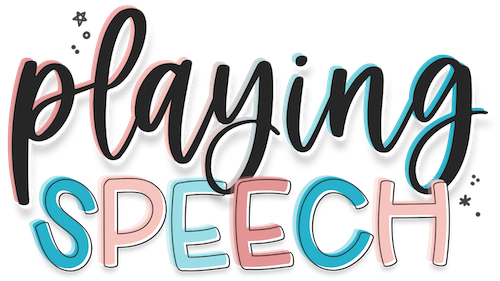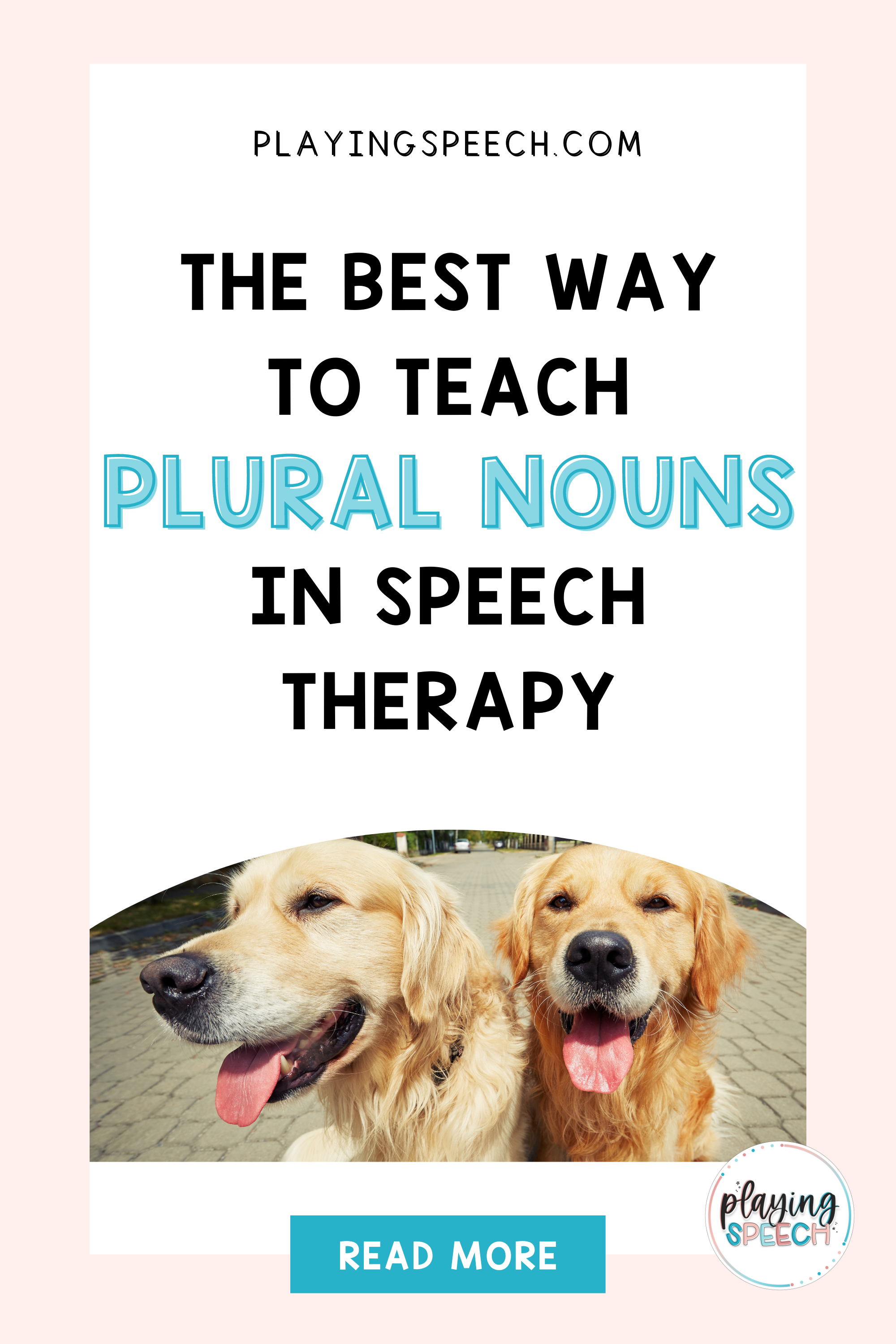The Best Way To Teach Regular Plural Nouns in Speech Therapy
Regular Plural Nouns In Speech Therapy: A Language or Speech Issue?
We all have that student on our caseload who needs to work on formulating regular plural nouns. But sometimes it’s difficult to determine if the problem with producing regular plural nouns is due to a language delay/disorder or due to a speech sound disorder. To further complicate matters, it may be that BOTH language and speech are impacting the child’s ability to produce plural nouns!
While it is important to understand the underlying etiology of the deficit (in this case, WHY the child is having difficulty producing regular plural nouns), it is not always so black and white. Sometimes a language impairment and a speech sound disorder coexist within the same child and make a specific concept difficult for the child to produce.
I was seeing this likely interplay of language and speech come up frequently in the case of producing regular plural nouns. Often the child would be stopping fricatives (like /s/ and /z/…which are sounds that are found at the end of plural nouns). Or the child would be demonstrating final consonant deletion and omitting whatever the ending sound(s) was altogether. Both of these speech sound errors impacted the child’s ability to produce regular plural nouns (and also third person singular verbs like “he walks”…but that’s for another post) properly. But I couldn’t really rule out the language component for sure due to the nature of the speech sound disorder.
So, since I was seeing this interplay of speech and language so frequently, I came up with an intervention that allows me to systematically target both the language concept AND speech sounds at the same time when working on regular plural nouns. I’m going to break it down for you.
How I Treat Plural Nouns in Speech Therapy
When I have a child with an obvious speech sound disorder who also needs to work on regular plural nouns, I like to break down the nouns by ending sound. If you recall, some plural nouns end in the /s/ sound (like “books”), some end in the /z/ sound (like “pigs”), and some end in an “is” sound (like “dishes”). By separating out the sounds, it makes it easier for a child with a speech sound disorder to accurately produce the plurals. They are only focusing on one ending sound at a time rather than on a mix of all 3 ending sounds. Think of it like blocked practice as discussed in the principles of motor learning literature.
So, first I teach the regular plural nouns that end in the /s/ sound as I find these are easier for the child to produce than the nouns that end in the /z/ or “is” sound. Additionally, I can use nouns that end in final /t/ (like “coat” or “kite”) to really help facilitate production of the /s/ sound. (If you elongate a /t/ sound, you naturally produce an /s/. Some call this “the long T sound” or “the flat tire sound.” Pam Marshalla has some good blog posts and text books on how to use this technique if you are looking for more info).
The next few bullet points are the activities I go though with JUST the regular plural nouns that end in the /s/ sound. After the child has mastered these next 3 steps, I’ll introduce the next ending sound (usually plurals that end in a /z/ sound) and repeat the steps.
Sort. The first thing I do is simply have the child sort picture cards into “one” and “more than one.” This ensures that the child receptively understands the language concept of plural before we work on producing plurals expressively. I have a huge set of picture cards (from this resource here) that I have the child place in two piles. One pile is for pictures of single items, and one pile is for pictures of more than one item. I don’t ask the child to specifically say anything, but I will comment as they sort. “Yes, that’s one kite, and those are two kites!” with emphasis on the final sound in the plural noun.
Drill with visuals. I use visuals to help drill the basic plural format. This works on both the language and the speech sound. I keep it consistent with pictures. Each item (let’s say a cat) has two pictures. One picture shows a single cat and the other picture shows 2 cats. I have the child use visuals of fingers counting (a hand holding up 1 finger or a hand holding up 2 fingers) to help them make the distinction between single items or more than 1 item. I also use speech sound visuals - a snake for the /s/ sound and a bee for the /z/ sound - to help the child to remember to add the ending sound onto the target plural noun. See picture to the right for an example of this.
So after they place the cards on the correct mat, I have them state “one cat” and “two cats” while pointing to the visuals. We do this multiple times with different noun exemplars. As we progress, I remove the speech sound visual (the snake or the bee picture) to try to fade cues and get the child working towards independently marking that plural sound.
Increase complexity with a carrier phrase. After I am confident that the child understands the language concept and can produce the final /s/ sound consistently at the end of plural nouns, I increase complexity using predictable carrier phrases. See the photo to the right. You can mix and match singular nouns and plural nouns at this step. But I still will only use the nouns ending in the /s/ sound.
Once the child gets through these steps with a single ending sound, I repeat these steps again with a new plural ending sound. So for example, we might do all plural nouns ending in the /z/ sound next. All the steps stay the same, I just change out the speech sound visual from a snake (for the /s/ sound) to a bee (for the /z/ sound).
Now You Can Start to Mix the Ending Sounds
Once the child has mastered the above steps with all 3 endings, I begin to mix up the regular plural noun ending sounds and work on all 3 sounds together.
Drill and Carrier Phrases. When the child has gone through each sound individually, I like to redo the drill and carrier phrase tasks while mixing and match the different ending sounds. So you just have a bunch of random nouns and complete the drill with visuals. Then you increase complexity to the carrier phrases, again with a mix of all 3 regular plural noun ending sounds.
Increase complexity with a games, play, and spontaneous speech. The final step is to really ensure carryover to conversational/spontaneous speech tasks by incorporating plural concepts into play, games, or conversational speech. I like to use the game “Spot It” which really lends itself to plurals. I also like Zingo (there are multiple of each item). You can use any play figures that you have more than 1 of (e.g. two cows, two kids). Potato Head works great for this because you usually can choose from multiple “eyes” and “shoes” and “hats.”
Do you want 75 regular plural noun cards organized by ending sound to get you started? How about all the visuals you need, too?
I created this resource for teaching regular plural nouns in speech therapy because I needed it with my own caseload. It includes explicit teaching pages, all the visuals you need, and 75 different word pairs (singular noun cards paired with regular plural noun cards, separated by ending sound). It has everything you need to teach regular plural nouns while focusing on both the language concept AND the speech sounds in you speech therapy sessions today! Check out the resource by clicking here.
Here’s what one buyer said: “This is such a brilliant resource and it finally made sense for my students who were struggling with plurals. The visual cues are so helpful and there are lots of different pictures to practice. I also love the option to include the pictures in sentences. I really love this product. It was a huge success in my therapy sessions.”
So That’s All About How I Teach Regular Plural Nouns
Please send me a comment or an email if you have any questions! I love chatting all things SSD. And check me out on Instagram @playingspeech. I am always sharing information regarding speech sound disorders!





